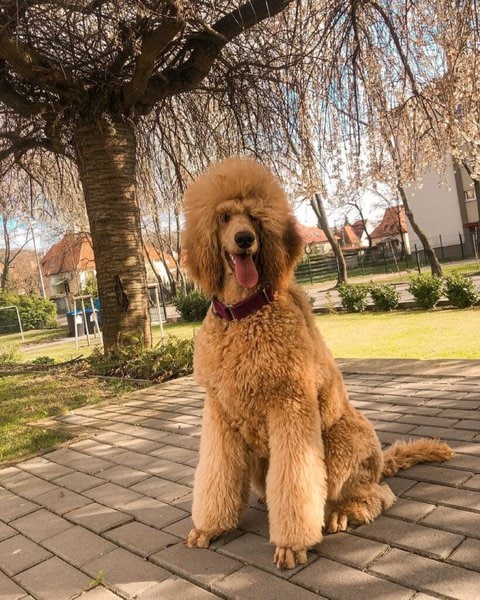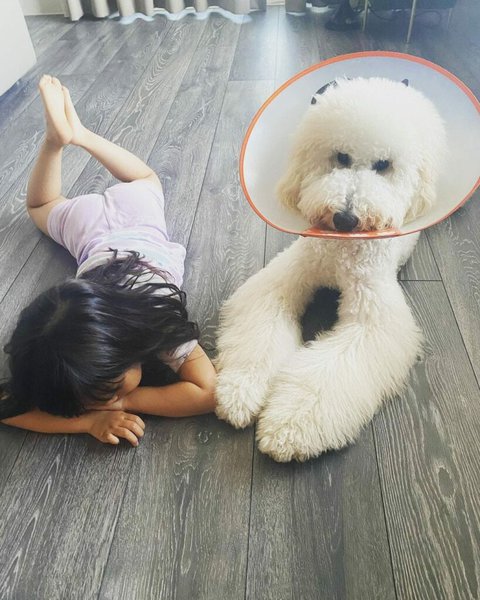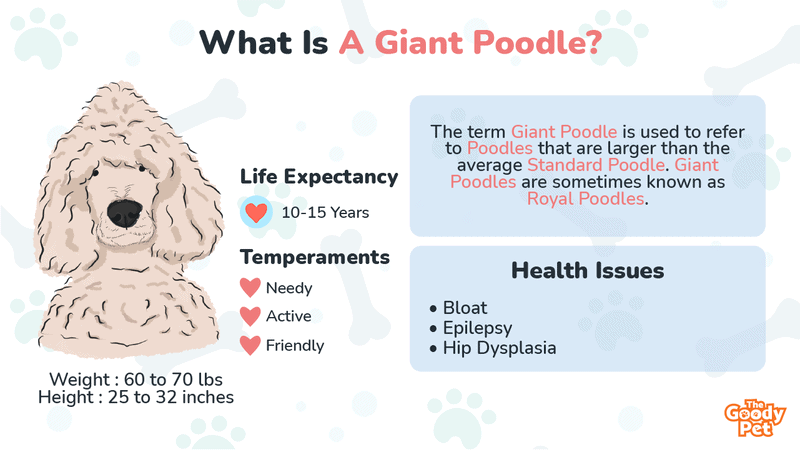There are people who love tiny dogs, and there are those who prefer keeping huge dogs. If you fall in the second group and are looking for a pooch that is huge but gentle, you’ll never go wrong with the Giant Poodle.
The term Giant Poodle is used to refer to Poodles that are larger than the average Standard Poodle. Giant Poodles are sometimes known as Royal Poodles. Breeders usually refer to these dogs using these terms so that they can charge more for them.
If you are one of those people who prefer huge dogs and are particularly interested in the Poodle breed, this article will furnish you with all the information you need to know about Giant Poodles. We’ll look at their size, potential health issues, their lifespan, the kind of care Giant Poodles need, and their personality traits.
Before that, however, let’s answer one looming question; is there really a breed known as the Giant Poodle?
Is There A Giant Poodle Breed?
The American Kennel Club recognizes three official Poodle sizes – Toy, Miniature, and Standard, with Standard Poodles being the largest. Giant Poodles are Poodles that fall on the higher extreme of Standard Poodles.
It’s important to note that Giant Poodles are not a distinct breed of Poodle. In addition, the term Giant Poodle is not officially recognized by AKC. According to the AKC, Giant Poodles are still categorized as Standard Poodles. The term giant is only used by breeders.
How Big Are Giant Poodles?
The term standard is used to refer to any Poodle that is over 15 inches in height and weighs over 45 lbs. The average Standard Poodle measures about 22 to 26 inches at the withers and weighs between 60 to 70 lbs.
In comparison, Giant Poodles measure about 25 to 32 inches at the withers, with their weight falling between 70 to 90 lbs. This makes them visibly larger than most Standard Poodles.
Appearance
Apart from the differences in size, there is no other physical difference between Giant Poodles and other Poodles. The Giant Poodle is a well-proportioned canine with dark, oval eyes, large and wide ears that hang close to the head, a narrow skull with a distinct stop, and a long neck that allows them to carry its head high.
Giant Poodles have a deep and moderately wide chest, a straight and level topline, and a dense coat with curly hair. Giant Poodles have a wide variety of coat colors, including red, apricot, black, white, brown, silver, and cream.

How Long Do Giant Poodles Live?
Research shows that larger dogs generally have shorter lifespans than small dogs. This does not, however, apply to Giant Poodles. Giant Poodles have a similar lifespan to other Poodles, so you can expect your Giant Poodle to have a life expectancy of about 10 to 15 years.
The large size of the Giant Poodle doesn’t give them any advantage when it comes to health. Giant Poodles are still at risk of suffering from diseases and conditions that affect other Poodles. Some common health issues among Giant Poodles include:
Bloat
Bloat, also referred to as gastric dilatation volvulus, is a potentially fatal condition that is very common among large-sized dogs. Actually, this is one of the most common health issues that Giant Poodles die from.
Bloat happens when a dog’s stomach fills with air and then twists on itself, blocking the flow of food into the stomach and the flow of blood into the stomach and intestines.
Hip Dysplasia
This is another condition that is very common in big dogs. Hip dysplasia results from the failure of the head of the thigh bone to fit snugly into the hip joint socket. It is a very painful condition that will affect your doggo’s ability to move properly and can lead to eventual paralysis.
Other Health Problems
Giant Poodles also suffer a slight risk of suffering from other health conditions such as epilepsy, sebaceous adenitis, canine hypothyroidism, and Addison’s disease. The best way to avoid most of these conditions is to ascertain that proper checks were conducted before breeding occurred.

How To Take Care Of Giant Poodles?
Dietary Requirements
Due to their large size, Giant Poodles have high energy requirements, and therefore, you need to make sure you are feeding them enough food. Giant Poodles will require about 4 to 5 cups of high-quality food daily, given twice a day (preferably in the morning and evening).
So, what is the best dog food for your Giant Poodle? Our top recommendation is Pet Plate dog food. We love the fact that all their recipes are expertly created by a vet nutritionist to ensure that their food delivers a balanced and nutrient-dense diet for your fido.
Even with a balanced diet, it is still advisable that you add some multivitamin supplements to your doggy’s diet. Multivitamins are important for improving your doggo’s health and giving them better immunity.
Tartar and plaque are also known to cause lots of dental issues for Poodles, so we recommend that you invest in dental water additives to minimize the risk of dental problems.
Exercise Requirements
Being a big dog with loads of energy, your Giant Poodle will definitely need lots of exercise and stimulating activities. Make sure they get over an hour of physical activity every day.
Fortunately, the Giant Poodle’s big size makes them great companions for exercising with. You can bring your Giant Poodle with you on morning runs, long hikes, walks around the block, tug of war, you name it.
In addition, Giant Poodles are excellent swimmers, which means that you can also give them adequate and enjoyable exercise by taking them to the beach.
Are Giant Poodles Aggressive? Temperaments Of Giant Poodles
Despite their large size, Giant Poodles are gentle giants.
They are friendly, social dogs and will hardly ever get aggressive toward people or other pets. They are sometimes reserved towards strangers, but even then, it is very unlikely for Giant Poodles to get aggressive.
Are Giant Poodles High Energy Dogs?
Yes, Giant Poodles have lots of energy and thrive best in situations that allow them to burn off this energy. This means that Giant Poodles are best suited for people who have active lifestyles.
If you hardly ever get out of the house, or if you hardly ever have time to spend with your canine buddy, the Giant Poodle is not the right dog for you.
Are Giant Poodles Easy To Train
Like all other Poodles, Giant Poodles have a high IQ. In addition, they are not a stubborn breed. This means that training a Giant Poodle is easy, especially if you start the training early enough.
However, you will need to keep varying the training; otherwise, the Giant Poodle can easily get bored and stop responding to training.
Are Giant Poodles Needy?
Another notable thing about Giant Poodles is that, despite being giants, they are needy dogs that need constant love and attention. Giant Poodles thrive best when they are next to their owner or family members and are not good at handling loneliness.
If you routinely leave your Giant Poodle by themselves, they can develop separation anxiety, get depressed, and start chewing on things like carpets and furniture.
Are Giant Poodles Hypoallergenic? Grooming Tips For Giant Poodles
Giant Poodles have the same kind of low-shedding coat that is present in all other Poodles. This makes them a great choice for people looking for hypoallergenic dogs.
Brushing
Giant Poodles are not high-maintenance dogs, despite having dense, luxurious coats. All you need to do is simply brush them regularly.
If your Giant Poodle’s coat is not clipped short, it will start matting and can lead to infections. To prevent this, you’ll need to brush your Giant Poodle daily. If your doggie’s hair is clipped short, however, you can brush their coat weekly.
One thing to keep in mind is that using the wrong kind of brushing tool can be damaging to your doggo’s coat, so we recommend using a proper brushing tool like the FURminator Undercoat Tool.
In addition to being safe for your furry buddy, the FURminator Undercoat tool also has an ergonomic handle that is comfortable for your hands.
Bathing
You will also need to give your Giant Poodle a bath from time to time to prevent dirt from accumulating on its coat and to keep the coat healthy and shiny. A good rule of thumb is to give your Giant Poodle a bath every three months.
To avoid skin sensitivity problems, always bathe your Giant Poodle using shampoos that are formulated for dogs and have the right pH balance for your dog. One good option is Mighty Petz 2-In-1 Oatmeal Dog Shampoo And Conditioner.
Related Questions
How Much Does A Giant Poodle Cost?
Giant Poodles will often be slightly more expensive than other Standard Poodles. You can expect to pay between $1,000 to $3,000 for a Giant Poodle. You should also keep in mind that you will incur other costs when purchasing your Giant Poodle, such as vaccination costs, microchipping costs, and licensing costs.
What Is The Difference Between A Standard Poodle And A Giant Poodle?
Giant Poodles are simply Standard Poodles that are bigger and heavier compared to the average Standard Poodle. Whereas the average Standard Poodle is about 22 to 26 inches tall, Giant Poodles are between 25 and 32 inches tall. Giant Poodles are also heavier than the average Standard Poodle, weighing in the 70 to 90 lbs range.
Can A Giant Poodle Kill You?
While it is possible for a Giant Poodle to kill you, the chances of this happening are exceptionally low. Giant Poodles are not dangerous. They are friendly and adorable dogs, just like any other Poodle, with the only difference being that they are bigger in size. They are gentle giants.





